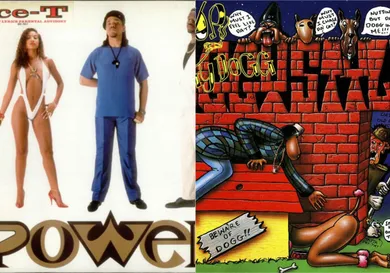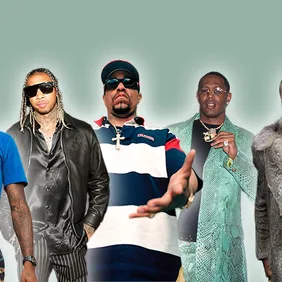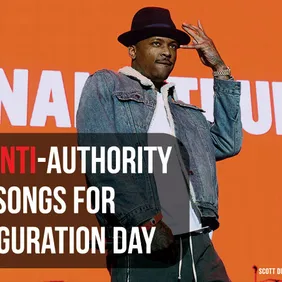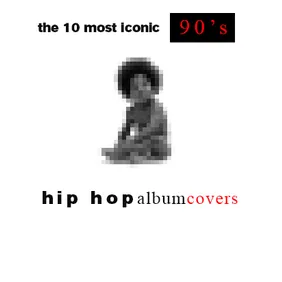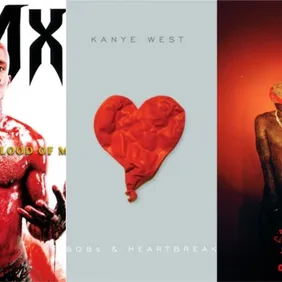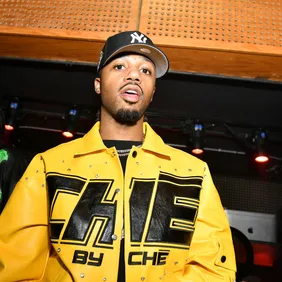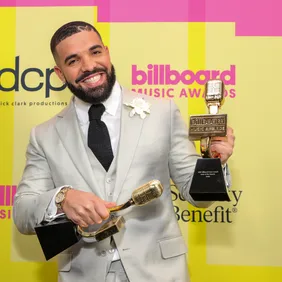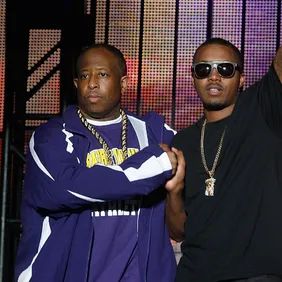At its inner core, hip-hop is an image-conscious subculture. Whether that is expressed through high-end apparel, tricked out automobiles or audacious jewellery, the aesthetic is something that many artists allocate a great deal of their time and effort to. A tool that’s used to elevate their stature in the rap game, the attempts to outdo and outdrip their peers has led many rappers to drop exorbitant amounts of money-- often in the millions-- on cultivating their look. Epitomized by Lil Yachty’s admission that he was once “addicted to buying jewelry,” what’s peculiar is that this meticulous attention to detail and resolve to best their peers doesn’t always extend to their music’s artwork. Whether it manifests in album covers or in merch, hip-hop has been plagued with an undercurrent of shoddily thrown together packaging. For every iconic snapshot of time such as Illmatic or Straight Outta Compton, there’s a cavalcade of slapdash photoshop or uninspired design templates to go with it. A plight in both mainstream and struggle rap circles, some of these offenders may have just fallen victim to the passage of time and technological limitations whereas others have just taken an apathetic approach to their music’s visual presentation and viewed it as a troublesome obligation.
In other cases, hip-hop album sleeves or merchandise can take on a life of its own for a vastly different reason in the form of an outpouring of controversy or backlash. A staple ever since 2 Live Crew and the image of them flanked by four buxom women was deemed obscene in the state of Florida, hip-hop artwork falling foul of censors and even aggrieved artists has been a recurring event throughout the ages.

J. Cole's "K.O.D." album cover, by Sixmau
In what was a far cry from the lacklustre portrait that graced his debut album Cole World: The Sideline Story, J.Cole’s 2018 record K.O.D is the latest to weather a storm of headlines. Rendered in a lavish colour palette, this depiction of Cole as a king shepherding a gaggle of drug-addled delinquents may have been controversial in the 80s but it’s not the content that has sparked debate recently. Although he’d signed off on its usage as an insert, Michigan-based artist recently conjured up a wave of dispute after he claimed that Cole had been less than transparent about his plans for the illustration:
“I did all the creative direction for the KOD album and he told me my work was only going to be used for booklet art. Only to turn around and make merchandise illegally with my art behind my back and profit majorly off it while on tour. F**k them.”
In a move that’s at odds with Dreamville’s image as a haven for creatives, he’s far from the only globe-trotting artist to come under fire for alleged plagiarism or straight up theft. Over the past couple of years, everyone from Chris Brown and Drake to Young Thug, Tekashi 6ix9ine and Kanye West have dealt with the contentious world of copyright infringement. In the cases of Lil Uzi Vert and Pusha T, the album artwork for Eternal Atake and Daytona embroiled them in surreal beefs with the remnants of the notorious Heaven’s Gate cult and Bobby Brown respectively.

Pusha T "Daytona" album cover, a photograph from Whitney Houston's bathroom circa 2006
Inconvenient as these disputes may seem, Uzi running afoul of a cult that committed ritual suicide in matching Nike Decades’ or Pusha incensing an ex-husband of a late pop icon is not necessarily a bad thing. In fact, history has taught us time and time again that hip-hop artists gaining the ire of the establishment through artwork has granted them the sort of organic publicity that money simply cannot buy. With Cole’s fracas as of yet unresolved, there’s an avenue to examine some of the most infamous cases of controversy-courting artwork in hip-hop and how these skirmishes gave these hotly-debated album covers and designs a life of their own.
While 2 Live Crew’s obscenity case set a precedent for hip-hop defying middle America’s values, their gaudy cover art wasn’t the first to spark uproar. Ice-T caused tensions to rise when he posed alongside DJ Evil-E and then-girlfriend Darlene Ortiz, who was not only dressed seductively but wielding a machine gun, for his Power album cover. As innocuous as this would be today, this image was far from commonplace at the time and led to claims that he was “perpetuating stereotypes” and glorifying violence. While the pinnacle of his time as a source of moral panic was still to come with 1993’s “Cop Killer,” his similarly named LA-based peer would cause pandemonium with a far more galling image. As if Ice Cube’s file at FBI headquarters wasn’t already bustling by 1991, he was about to find himself the subject of a state-wide ban. The release of his sophomore solo project Death Certificate in March of that very year was a turning point for Cube in more ways than one. Anarchic and unrepentant in its lyricism, an album with such strong convictions came complete with a similarly stark piece of artwork. Given its scathing examination of societal injustices in America, the image of Cube hovering over the Uncle Sam’s toe-tagged corpse in the morgue is a fitting representation of the music that awaits you. However, this proved to be far too inflammatory for Oregon’s local government. In conjunction with boycotts and calls for its removal from stores across America, the Beaver state took things to overzealous levels by imposing a blanket ban on any image of Ice Cube in a retail outlet. As a result, Cube’s advertisements with St Ides malt liquor were consigned to the trash heap. Despite their best efforts to raise trumped-up moral panic, it didn’t stop the album from going platinum within two months of hitting the shelves.

Ice-T's "Power" album cover, photographed by Glen E. Friedman
At a time when suburban America’s apprehension over supposed gangsta rap was at an all time high, this same reactionary terror would work wonders for artists from across the nation. In 1993, the MC then known as Snoop Doggy Dogg became a totem of hip-hop’s cultural ills for one of the most persistent anti-rap activists. Decried as a “motherf****r” by 2pac on “How Do U Want It,” C Delores Tucker led a band of her fellow concerned elder stateswomen in defiance of Snoop’s debut album Doggystyle. In a report from The Washington Post, news writer Paul Farhi described a scene at the site of one of her public condemnations of the genre’s direction:
"Loudly competing with shouted slogans like "Our women are queens -- they're not 'hos, they're not bitches" were The Wiz's blaring outdoor speakers and construction noise from across F Street. Protesters took turns holding up a poster of the XXX-rated comic-book-style cover of gangsta rapper Snoop Doggy Dogg's new album, Doggystyle."

Snoop Dogg's "Doggystyle" album cover, by Darryl ‘Joecool’ Daniel
Unwilling to stop there, the album cover was also enlisted as evidence during a hearing on “Commerce, Competitiveness, and Consumer Protection.”
Snoop is far from the only man to profit from outrage. Provocative covers such as Geto Boys’ We Can’t Be Stopped, which featured an image of Bushwick Bill making his way through the hospital after he was shot in the eye by his girlfriend, the Christlike iconography of 2Pac, or in this case, Makaveli’s, posthumous album The Don Killuminati: The 7 Day Theory and Master P’s Ghetto D all got that extra boost of notoriety due to the anger and abhorrence they whipped up. In the case of the latter, the album originally known as Ghetto Dope featured an image of a man inhaling deeply from a crack pipe. After it was pulled from shelves, he trimmed down the title and replaced the cartoonish drug use with a hastily patched-together replacement. Nevertheless, the album went to number 1 and is 3x platinum as of 2006.
Rather than these incidents being a relic of the '90s, their modern-day counterparts have heeded the example of their forebearers on numerous occasions. In a sterling example of hip-hop’s awareness of controversy as a marketing implement, the man behind Kanye West’s mythical creature sex from My Beautiful Dark Twisted Fantasy has said that the response it elicited was not just fully anticipated but the preferential state of affairs.
According to artist George Condo, he was commissioned to devise "eight or nine paintings" for West and that he was in the pursuit of "something that will be banned."
While Kanye may have allegedly incurred the top brass of Walmart with the cover, his “Wouldn’t Get Far” and “Crack Music” collaborator The Game took it upon himself to anger an even higher authority just two years on.
Crafted by artist Mike Saputo, the cover of the Compton rapper’s fourth album Jesus Piece sees its namesake reimagined on stained glass with a teardrop tattoo, red bandana and chain. Although he’d later unveil a less sacrosanct sleeve, The Game spoke of his intention and the fallout that he incurred from none other than a Christian institution:
"The Roman Catholic Church called Interscope and it got really crazy. That was my plan, That album cover was always the deluxe album but I put it out first because I knew what it was going to do controversy-wise. It did what I wanted it to do and everyone was pissed off."
Whatever the conclusion of J. Cole’s intellectual property altercation with Detroit’s Sixmau may be, it’s abundantly clear that controversy never hurt the mythology that surrounds a hip-hop record and if anything, can add a unique dynamic to its longevity.
